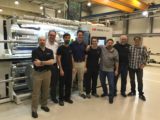Paper Converting Machine Co Wins 2019 FTA Technical Innovation Award for SteadyPrint
May 8, 2019While you literally put a Band-Aid on something—like a cut or a wound—it is never a good idea to figuratively “put a Band-Aid” on something—like a problem or a dilemma.
To put out a fire, you don’t point an extinguisher at the tips of the flame; you spray its base. To fix a ceiling leak, you don’t put a bucket down to catch the water and then continually empty it; you close the opening on the roof. To deal with a squeaky brake on a car, you don’t crank up the volume on the radio; you bring it to a mechanic and have it looked at (and wind up paying to have seven other things fixed).
“Putting a Band-Aid” on something is a short-term solution. It should be done when a problem can’t be foreseen, and only until there is time to find a real remedy to the underlying issue.
Paper Converting Machine Co (PCMC) had a similar line of thinking when evaluating common problems faced by its customers—specifically the persistent issue of bounce. “The idea came from the fact that every flexographic printer struggles with certain bounce jobs,” explains Rodney Pennings, the company’s director of sales. “The team at PCMC thought that if we could create something to help alleviate issues with that pain point, it would also help combat the challenges of shorter run lengths and printing higher quality products with a faster turnaround time.”
To fight that fire, plug that leak and quiet that squeak, the company created SteadyPrint, a combination of hardware and software that has shown in PCMC’s testing to reduce bounce and improve press speeds anywhere from 200 percent to 400 percent, while reducing waste by 35 percent. For the achievement, the company was awarded a 2019 FTA Technical Innovation Award, the only winner in the Heavy Metal category.
SteadyPrint reduces press bounce and its side effects. Above, a pair of
images from a job run without SteadyPrint; below them, the same job run with
SteadyPrint. Overimpression and dot gain are greatly reduced.
All photos courtesy of Paper Converting Machine Co
“We entered SteadyPrint in the 2019 FTA Technical Innovation Award competition because we recognize that it is cutting-edge technology,” Pennings states. “It is an innovation that we are extremely proud of, and we appreciate the accolades that showcase it within the package printing industry.”
Brainstorming to Beat Bounce
Press bounce is not something new to flexographers, and the number of remedies to it that already exist—bearer bars, job staggering, specialized plate/tape combinations—is a testament to its continued persistence as a thorn in many a printer’s side.
Pennings describes a design that could have come off press decades ago—“an image with full cross-web solid lines or heavy coverage at the leading edge of the print”—as a typical bounce-prone job, and says the problem is only compounded for those printers making use of expanded gamut (EG). “The combination of challenging artwork with process screens required to hit brand colors and the use of EG creates further challenges for printers.”
Looking to fix a problem that had both staved off previous solutions and was still finding ways to interfere as printers take on more complex designs, PCMC more than two years ago began work on what would become SteadyPrint. The company held “innovation sessions” where a team of engineers, product managers and customers brainstormed new approaches to beating bounce. Those meetings yielded various ideas, each of which was tested internally and at customers’ facilities. Through iteration, redesign, re-evaluation and repetition, SteadyPrint was born.
One aspect Pennings says was “fairly apparent” from the beginning was the need for a software component in addition to a mechanical solution. That hunch bore out in the final design of SteadyPrint, which is two-parts-hardware-one-part-software and can only be found on PCMC’s Fusion Max, Fusion, Fusion Compact and ELSMax presses. Those three parts:
- Conventional blocking and tackling of mechanical design aimed at minimizing deflection of key components of the deck
- A mandrel support arrangement that increases deck stability
- A disturbance-canceling algorithm that uses artificial intelligence to “learn the electronic signature” of each job and “cancel out the negative effects of challenging graphics”
Put together, Pennings believes they “increase both deck stability and the printer’s ability to run challenging print jobs with greater ease.”

